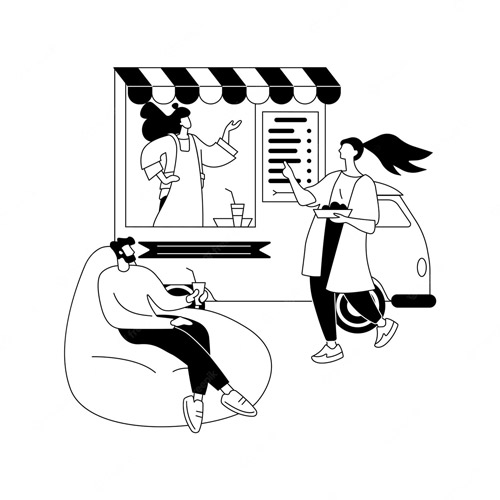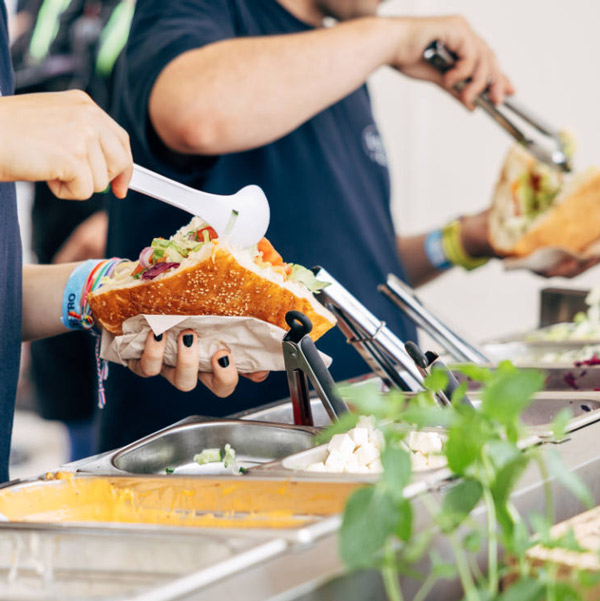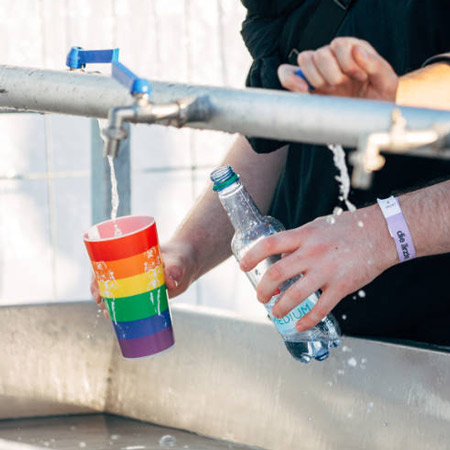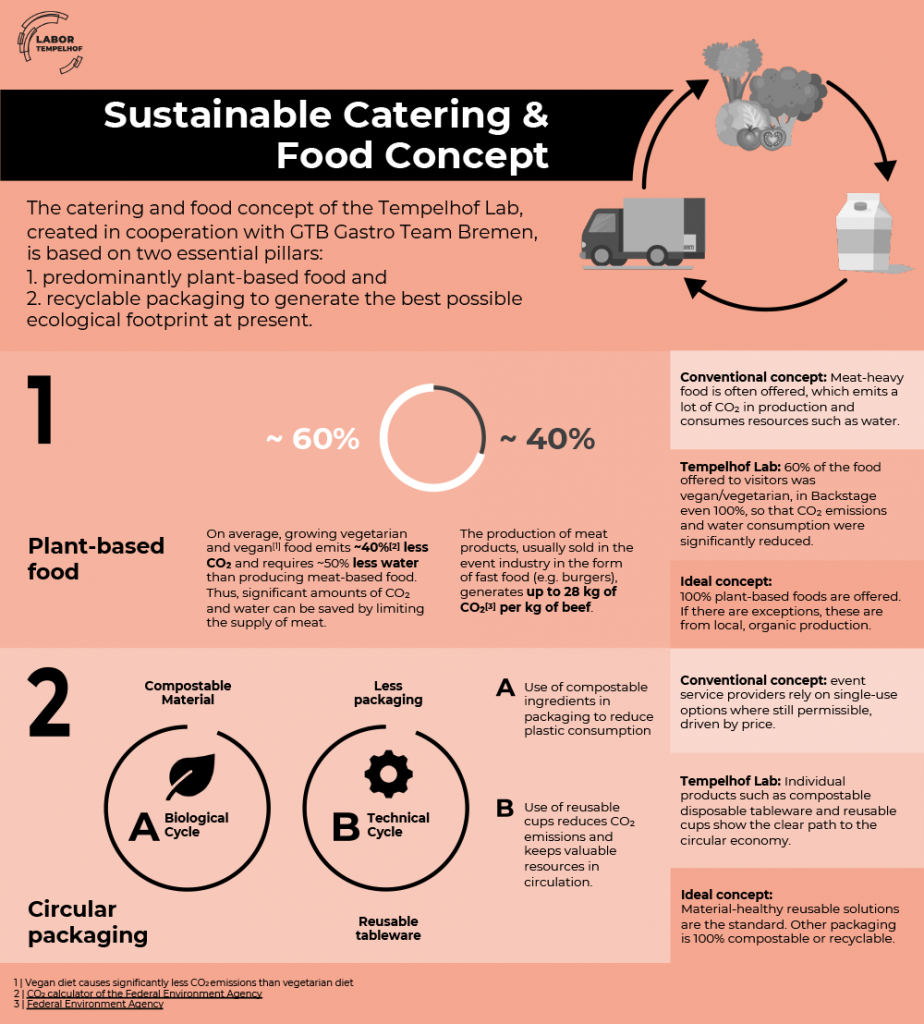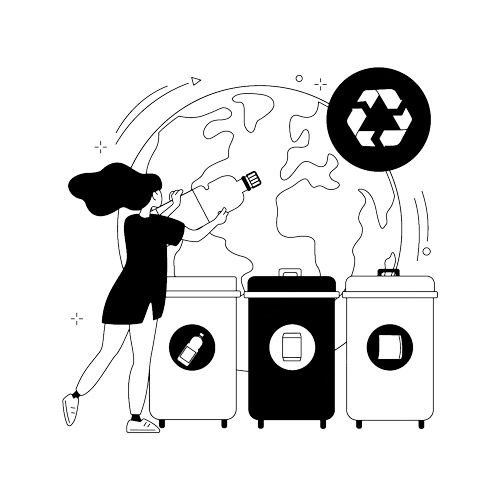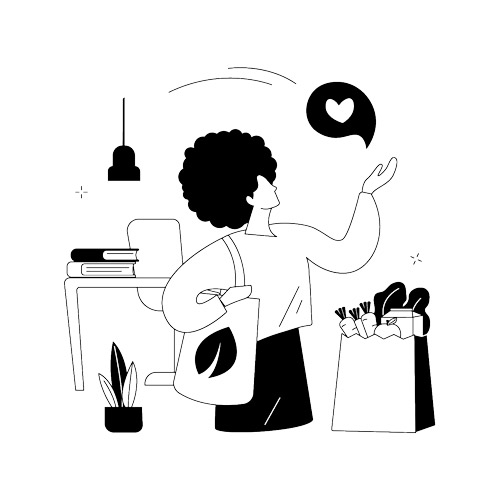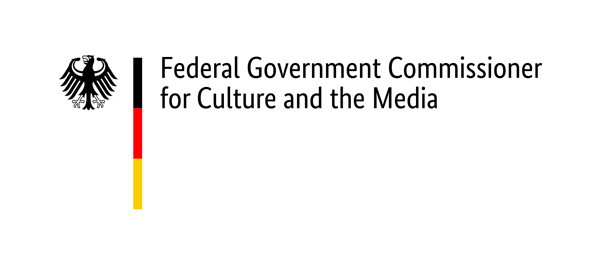1. Overview and problem statement
Did you know…?
A vegetarian diet could reduce the global greenhouse gas emissions around 63% and a vegan diet around 70%?22
In the context of large scale events, highly processed, quickly prepared and inexpensive food is typically used to enable the sale of a large volume of items in a short time. Most often, food from conventional agriculture is used, the production of which involves the use of harmful chemicals such as pesticides. Conventional agricultural practices make the food less healthy and pollute the soil. Large events also typically offer food made with animal products. Along with mobility and energy, switching to plant-based food sourced from regenerative agriculture is one of the biggest factors in making an event as climate- and resource-positive as possible.
The challenge of sustainable, circular event-planning is, among other things, to create the shift towards a plant-based diet – regarding the availability and scalability of vegan/vegetarian dishes as well as regarding the emotional level with the audience and the people on the production team. Another major action item is excessive food preparation due to miscalculation and the composting of food waste generated during preparation.
Another consideration is the use of packaged food by caterers and food vendors. Additionally, food is often served on disposable tableware. However, since January 1, 2023, caterers with more than 80 square meters of sales area or more than 5 employees have been legally obliged by EU laws to provide their customers with reusable packaging for takeaway food and beverages. 23 In the case of food packaging, it is still mostly disposable plastic packaging that contains harmful substances such as plasticizers.
Das Thema Ernährung ist emotional sehr behaftet. Gleichzeitig können Veranstaltungen ein Ort sein, Menschen für eine alternative Ernährungsweise zu begeistern und zu inspirieren – die Qualität der angebotenen Lebensmittel und die richtige Kommunikation sind hier absolut entscheidend.

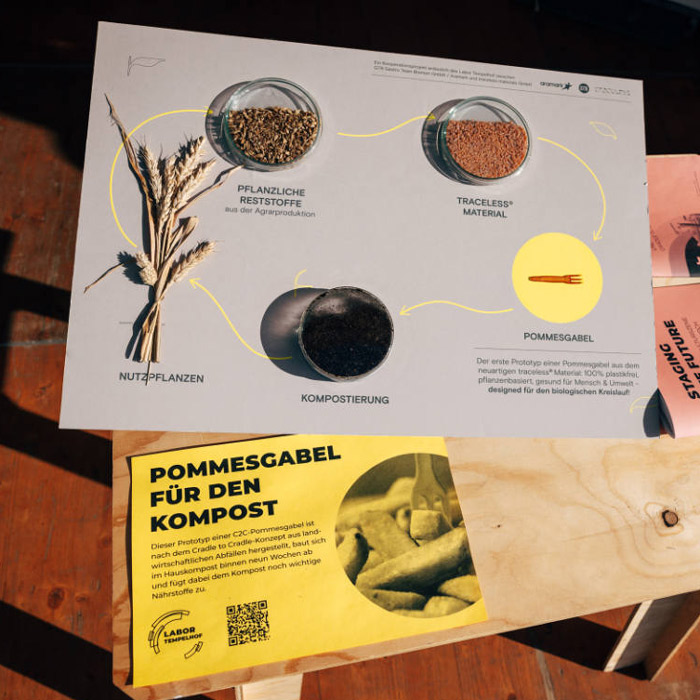

2. Our Benchmark for Tempelhof Lab
An event that aims for complete circularity and sustainable procurement in the area of food and catering considers the following criteria:
- Ideally offer exclusively vegan food from regenerative agriculture for the public, crew and bands. The food plan should have positive effects on the greenhouse gas emissions, soil- and water consumption, use of pesticides and the quality of agricultural land.
- Rethink the leftovers and waste as a source of nutrients: if they cannot be avoided in the production, then collect separately for later composting or recycling as biogas.
- Source all foods from regenerative agriculture with at least an organic certification. For items like coffee, cocoa, wine, sugar or chocolate, which often are conventionally produced in poor working conditions with child labor, seek a fair certification (for example direct trade or fair trade).
- Only buy food in recyclable packaging or, even better, offered as part of return and deposit systems.
- Have food stalls serve food exclusively in recyclable or reusable dishware.
- Communicate positively about the proportion of vegan or vegetarian dishes offered, without passing judgment on anyone’s daily dietary habits.
- Free drinking water for everyone.
3. What worked well, what can be improved?
Tempelhof Lab took various measures to optimize food and catering in the direction of sustainability and circularity.
Food vendors
What worked well?
- The organization of food stalls specialized in vegan and vegetarian dishes that are able to feed 60,000 concertgoers in a short period of time was a big challenge coming out of pandemic restrictions. Still we attained a proportion of 60% vegan and vegetarian dishes.
- Through intensive planning discussions with the caterer to shift focus to plant-based food, we raised awareness on these issues with one of the leading catering providers..
- Informational displays at the food stalls on the CO₂ balance of the meals offered.
- Free drinking water in public areas.
- Printed reusable drinking cups with deposit.
- Educational projects in Cradle Village: The Bread-Beer Truck: beer brewed with food scraps.
- Educational projects in Cradle Village: A 24-hour composting system that processes vegan food scraps into humus.
- Pilot project initiated in the food service sector: French fry fork made from compostable alternative to plastic from agricultural waste.
What can be improved?
- Reach the target of 100% vegetarian-vegan dishes.
- Offer reusable tableware at all food stalls and implement a corresponding dishwashing system.
- As an alternative to reusable serving dishes at all food stalls, vendors agreed to use compostable dishes. However, this was not fully implemented overall.
- Accountability measures to ensure vendor compliance with stipulations, like using recyclable packaging, certification of food sources etc.
- Sourcing food and beverages exclusively from companies that have transparent and controllable supply chains and where organic raw materials are processed. Balancing this objective with short delivery distances.
- Production and scaling of a French fry fork made from a compostable plastic alternative was not completed in time; only prototypes were available. Ideal case: project continues long-term and product goes into mass production. That was not the case as of July 2023.
Catering for Production, Bands & Crews
What worked well?
- 100% vegetarian and vegan meals offered backstage and in the production area.
- Use of reusable coffee cups.
- Reusable dishes and cutlery.
- Refillable reusable bottles were distributed before the tour to Die Ärzte, Die Toten Hosen, and their crews.
- In the case of Die Ärzte: Via Rider, an attempt was made to avoid products from companies that are non-transparent, do not use organic raw materials, and are publicly criticized with regard to their supply chains, their business model, and their environmental and labor practices. Verifiably successful with Nestlé products. 24
- A drinking water dispenser in the Artists area.
What can be improved?
- Availability of a tap water- with reusable mugs in the entire production area. Due to hygiene concerns and infrastructural challenges, this was not implemented.
- Reliable infrastructure for the availability and collection of reusable mugs.
- Stipulation, that the table napkins used in catering must be biodegradable, and can be composted with food scraps.
Food Stuff Remains and Disposal
What worked well?
- Avoiding food waste by donating leftover food to various initiatives (climate new start, ambassadors of C2C NGO).
- Use of vegan food waste in the educational project on the 24-hour composting plant.
What can be improved?
- Purchase of exclusively regional food from regenerative agriculture with delivery using reusable boxes/large containers, return and deposit systems for packaging, or recyclable packaging.

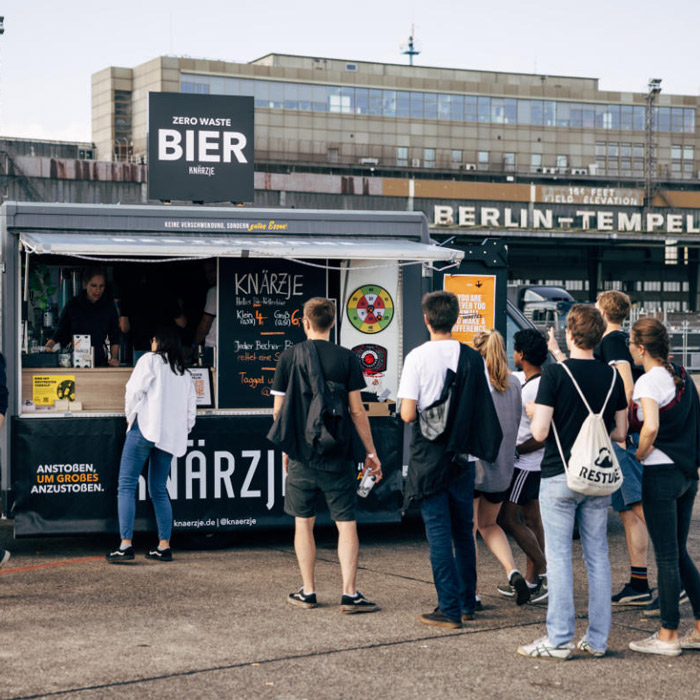

4. Findings and Recommendations
Food Stall Menus:
- The food offerings have an immense influence on water consumption at an event. By offering 60%25 vegan- and vegetarian dishes in the public area and then purely vegan- and vegetarian catering backstage, Tempelhof Lab consumed around one third less water than conventional concerts of this scale26. This resulted in conserving around 91 million liters of water.
- In the area of food and catering, Tempelhof Lab’s concerts emitted around one fourth less CO₂ than conventional concerts of this scale. This equals about 76 fewer tons of CO₂.
- Procuring exclusively vegetarian and vegan dishes remains a challenge.
- Discuss with the caterer early on in planning to ensure the required quantity.
- Long term: Communicate with the caterer with the aim that they will continuously expand their vegetarian and vegan menu for future events .
- Onsite fewer vegan and vegetarian meals were offered than promised.
- Onsite control to compare demanded/confirmed meal quantities with actual menu offers.
- Event organizers should consider this situation in advance and weigh options for action. It is conceivable that menu offerings could be part of the terms of the contract with the caterer.
- The vegan and vegetarian fare were received well. However, we observed and confirmed that the audience consisted mainly of people who are open to a meat-free diet. The following incentives can be created for an audience that prefers a meat-based diet.
- Place vegan and vegetarian food stalls throughout the venue and in high traffic locations/walkways.
- Adjust prices to reflect the real cost of meat-based meals.
- Communicate the CO₂ balance of individual dishes more visibly, highlighting dishes that have a particularly low CO₂ balance or are resource-positive.
- In order to measure the impact of the measures taken and to further improve future events, it must be known as precisely as possible which dishes were purchased particularly frequently or particularly little at which location.
- Talk to the catering provider at an early stage about such data collection and reporting. If necessary, make it a contract term or deliverable.
- Measurement and communication can be challenging, especially at large events, due to the high number of subcontractors used by catering providers.
- At Tempelhof Lab the ideal – the construction of a system to deliver and return reusable dishware and cutlery for a concert with 60,000 attendees was not feasible.
- For smaller events, multiple day events and fixed venues, the use of reusable cutlery is simpler and should be the preferred solution.
- If the use of reusable dishware is not possible, then the use of exclusively biodegradable/edible tableware should be planned, demanded and controlled in advance with the caterer. Disposal of serviceware must be planned.
- Food service and the topic of disposal must be thought through together and coordinated at an early stage.
- Ensure separate collection of food scraps by food stalls and subsequent recycling in composting or biogas plants.
- In describing the menu on offer to the public: Highlight the potential, avoid deterrents.
- To not characterize dishes explicitly as “vegan” or “healthy”. Everyday life shows: this can discourage people from buying the meal.
- Best practice: describe the type of meal and highlight the flavors, for example “Spaghetti with succulent Lentil-Tomato Bolognaise”.
- Focus on positive characteristics, for example through labeling the dish or the stall with the best CO₂ balance and/or a resource-positive balance. 27
- Leverage market power
- Large event organizers, big venues and well known bands/artists can place very concrete demands on breweries, beverage distributors, catering companies and foodservice providers: on the quality of the product, the type and manner of their production, as well as the type of packaging and the delivery. This market power can be used to drive a change toward climate- and resource-positive events, not just selectively for one event, but fundamentally and systematically.
Catering for Production, Bands & Crews
- Beverage supply in the production area/backstage can be switched completely to reusable containers.
- Provide drinking water stations and, if necessary, premix stations.
- Ask employees to bring their own refillable bottles/cups.
- Provide a certain number of reusable bottles/cups (possibly for a small deposit).
- In addition to the actual food selection (vegan-vegetarian, organic and fairtrade), clarify other climate and resource-relevant issues early on in discussions with the catering providers.
- Disposable napkins made of biodegradable material.
- Reusable dishes and cutlery.
- Focus on reusable, recyclable packaging solutions with deposit/return systems if necessary.
-
- Pure vegan/vegetarian catering is easy to implement.
- Select a catering provider that has experience with alternative food offerings or already meets the specifications/preferences of event organizers.
- If the venue is bound to a certain provider, talk about the required food offer (vegan-vegetarian, organic, fairtrade) at an early stage and find compromises. Show the economic and strategic potential of vegan-vegetarian catering.
- The more often it is communicated to production employees/crews to opt out of meals they will not eat, the more food waste will be reduced.
- Raise additional awareness of the link between food waste, RSVPs/signing up for meals and cancellations.
- Pure vegan/vegetarian catering is easy to implement.
5. Service Provider Contacts

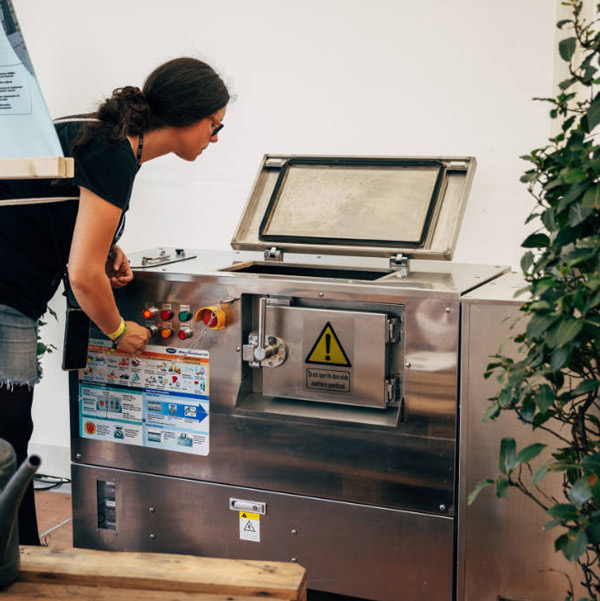

6. Further inspiration from the industry
Other events and festivals also focus on the topic of food and drink:
The Swedish Way Out West Festival (capacity 35,000) has been offering exclusive vegetarian and vegan dishes since 2012. Way Out West publicizes the carbon footprints of all dishes and beverages and provides them with their own CO₂ label. Today the proportion of vegan dishes is at 70% – without resistance or opposition; instead, the event receives extensive media coverage and positive associations with the event’s brand, including increased food and drink sales. 28
All food sold at the Tollwood Festival (capacity 1.5 million) has been certified organic in accordance with the EU Eco Regulation since 2003. Products such as tea, coffee, rice, wine, bananas, cocoa, sugar or chocolate products produced in the Global South are Fairtrade certified in addition to the organic seal. At the same time, the festival makes sure that organic dishes on offer are no more expensive than conventional dishes at other major events. 29
The Northside Festival from Denmark (capacity 35,000) offers exclusively vegetarian dishes and collaborates with Plantebaseret Videnscenter, a research- and knowledge platform for the transition to plant-based foods. In 2022, the festival limited food vendors’ menus to no more than 20% animal components such as cheese, mayo, eggs, consistent with the planetary boundaries. For some Northside caterers, the shift to vegan or vegetarian offerings has been a real catalyst, bringing about tremendous growth for their businesses. The higher the organic content of a food vendor’s dishes, the lower the booth fee, which is why organic is very well implemented. The Northside Festival has asked the Tuborg brewery for organic beer, which began production specifically for the festival and resulting in a product with 50% fewer emissions. 30
The Breminale is a five-day free outdoor cultural festival with approximately 220,000 visitors each year. To minimize pollution of the adjacent Weser River, since 2022, all drinks and food have been served in reusable containers. This avoids around 2.6 tons of waste. 31

